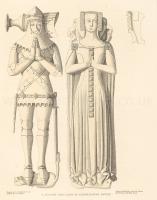Text this colour links to Pages. Text this colour links to Family Trees. Place the mouse over images to see a larger image. Click on paintings to see the painter's Biography Page. Mouse over links for a preview. Move the mouse off the painting or link to close the popup.
Effigy of a Basset and Lady at Atherington is in Monumental Effigies of Great Britain.
THIS ancient family, of which two branches were settled in the county of Devon, possessed the manor of Umberleigh, in the parish of Atherington, where they had a mansion. That renowned monarch of the Saxon dynasty, Athelstan, is said to have had a palace at the same place, and to have endowed the churches of Atherington and Bickington adjoining parishes, with land and other privileges.
Note a. Risdon gives the laconic form of the grant, which should put the scribes of modern instruments to the blush, "Ich, Athelstan, King Grome of this home, geve and graunt to the Preste of this Chirch, one yoke of land freely to hold, wood in my holt house to build, bytt (i. e. biting) grass for all his beasts, fuel for his hearth, pannage for his sow and pigs, world without end. Amen."

Polwhele says that these are the effigies of "Sir Arthur Basset and Elinora his wife". It appears from Mr. Stothard's journal of his journey into Devon, in May 1821, in search of subjects for his work, that this was the last monument he ever drew, but four days before the fatal accident which terminated his mortal career. He speaks of the effigy of a knight, in the style of that of William Longespee, as being brought from the ruins of Umberleigh, in the neighbourhood, and placed in Atherington church. He continues: "Besides this figure, there is a tomb on the north side of the church for a Knight and Lady temp. Richard II. The arms on his surcoat, a saltire vaire. By a repetition of the last in another part of the church, I could ascertain that the held was Gules. Prince describes the coat of Basset as barry wavy of six Or and Gules. Crest, an unicorn's head, on the neck two bars indented Gules. The figure of the knight presents the novel appendage of a mantelet, or covering for the camail, adorned with a scallopped border, similarly to the surcoat. On his basinet is a jewelled circlet, or wreath, ornamented with roses. The coiffure of the female is a fret of the square form, the frontlet of which bears a row of 00's, probably as the initial letter of the blessed Virgin's name. Mr. Stothard's original drawing has been very faithfully followed in the etching; but no needle but his own could give an idea of its pure taste and elegant precision.
Details. Side view of part of the head, the fret and coif.